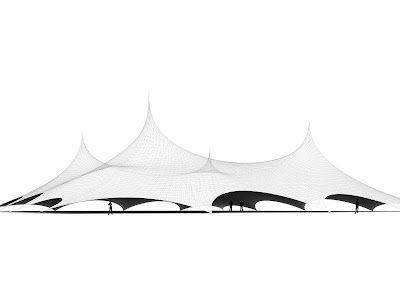these are the first images of our arduino/processing project. the aim is to develop a data collection machine - eqipped with sensors - which corresponds with processing in realtime. there are different methods of the data visualisation. realtime, realtime with visualisation of former values received and long time mapping.
in this example we tested 6 light sensors.
Monday, December 6, 2010
Wednesday, December 1, 2010
raumkasten
short design course with ariane müller hosted by prof. herbert bühler in munich. it is about a reorganisation of the famous stachus-plaza close to the main railway station.
rhino membrane
victoria and my trying to understand rhino membrane. we did a small tutorial for the program. here are the examples that are described in the tutorial.
Wednesday, June 30, 2010
rhino python
as the new scripting language in both rhino 5 and rhino mac will be python there is already a new forum. the same scripts can be run in both versions. python allowes to make your own rhino commands, line .net plugins in rhino 4.
in both work-in-progress versions scripting with python is possible now.
I am looking forward to the new rhinos...
Tuesday, June 29, 2010
rapid protohousing
mass customization: the use of flexible, computer aided manufacturing systems to produce custom output.
index model: programmed framework of a design concept, that needs specific user input to generate final adjusted designs.
this is carlas and my suggestion for the last concrete design competition. we tried to develope a room generator, that computes possible living situations for a user-specific room program.
Wednesday, June 16, 2010
digitales entwerfen - first image
victuria hlubek`s and my first result of our digital design course hosted by norbert palz at the msa. it is a pedestrian bridge that uses the structure of an old cargo-train bridge...
we did the generation of planar elements in grasshopper.
Tuesday, June 1, 2010
subdivision
inspired by the cracking algorithm of aranda/lasch published in "pamphlet architecture tooling" I did this one. in this case there are 7 generations of crackings with a 5 % chance to abort.
Tuesday, May 11, 2010
entropy
chaos is only the result of a complexity that is too complicated for us to understand. each chaotic system can be predicted if we have enough information to synchronize. it is amazing to see how bigger patterns evolve in such a chaotic, "random" system.
3 lines in each picture, each line consists of 1000 single elements.
3 lines in each picture, each line consists of 1000 single elements.
Wednesday, February 10, 2010
the first...
this was part of the very first digital project I did. it was a collaboration with jascha lehmann and we were so damn proud of using rhino,scripting and the 3d plotter for the first time!
it was a time when voronoi structures were new, cool and exciting...
here is the homepage of the digital lab from our university where it was printed.
it was a time when voronoi structures were new, cool and exciting...
here is the homepage of the digital lab from our university where it was printed.
digital prefabrication
this is our parametric curtain, developed in the digital prefabrication course, hosted by steffen riegas (UNstudio). The aim of the course was to create a every-day-life product based on a radiolarium structure by ernst haeckel (1834 - 1919) and to experience the whole digital way from design to final 1:1 production.
We did the structure in grasshopper, adjustable parameters are the size of the window, the depth of the curtain, the strength and the position of the attractor point, the material flexibiliy and the influence of gravity.
After baking the base curves we rhinoscripted the identifying, colorcoding and sorting of the curves, the joining and lofting of the surfaces and the unrolling. Before the files were ready to lasercut, we added construction extensions and rebuild the curves to make them smooth.
Subscribe to:
Comments (Atom)


























































